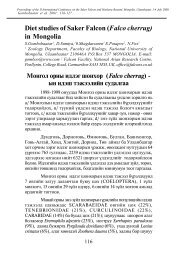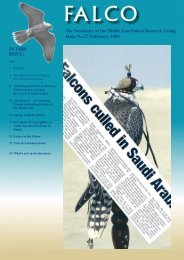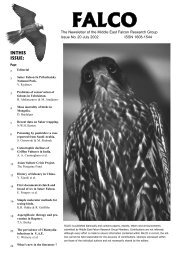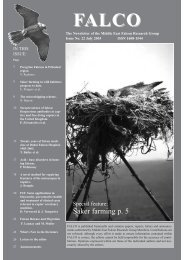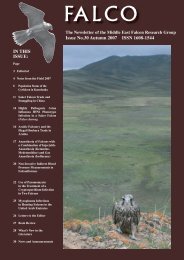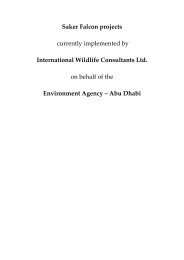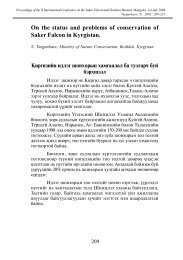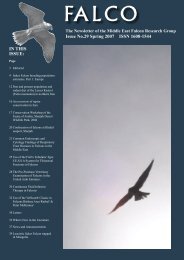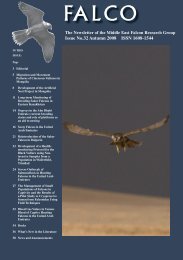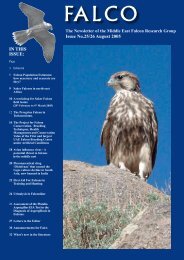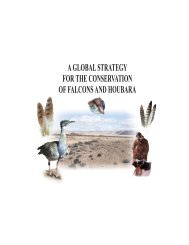Falco cherrug - International Wildlife Consultants Ltd.
Falco cherrug - International Wildlife Consultants Ltd.
Falco cherrug - International Wildlife Consultants Ltd.
Create successful ePaper yourself
Turn your PDF publications into a flip-book with our unique Google optimized e-Paper software.
Caspian Sea<br />
Figure 4. Historical range of the Saker in European part of Russia. Enclaves are marked with numbers and discussed in the<br />
text.<br />
Tobol- Ishym rivers (1, Figure 4); at the forest strips along<br />
the Emba and Ural rivers (2 and 3, Figure 4); the southern<br />
tip of Urals (4, Figure 4); and in the eastern (5, Figure 4) and<br />
western (6, Figure 4) Volga Highlands. During the catastrophic<br />
decline of the Saker in the 1970s all populations,<br />
except that in Tobol-Ishym, ceased to exist. The mentioned<br />
areas contained scarce breeding pairs here and there, numbers<br />
of which declined steadily up to 1990s.<br />
The Saker population crash coincided with widespread<br />
peregrine-DDT contamination well documented<br />
elsewhere (e.g. Cade et al. 1988, Ratcliffe 1990), a massive<br />
development of pristine steppe, and a sharp decline in quarry<br />
species (such as Sousliks), which were severely controlled<br />
on arable lands. In contrast to the peregrines, the<br />
Saker has not been able to recover because its most productive<br />
areas happened to be those under intensive agricultural<br />
pressure at the time, and there were no refuges, in which to<br />
let the species survive, except those of the Tobol-Ishym<br />
region and Mugodzhary (Kazakhstan). It is the latter regions<br />
that acted as source populations in the later years. However<br />
the slow recovery has been confounded by an intensive wild<br />
take by bird traffickers. Slow re-colonisation does take<br />
place in the southern Urals and regions east from Urals. In<br />
particular we found 2 new nests in Bashkiria at the southern<br />
tip of the Urals in 1999 (Karyakin et al. 2001). There were<br />
no Sakers recorded here, but the area was densely populated<br />
by peregrines. The appearance of the bigger Sakers led<br />
some of the peregrines to shift their territories. In 2000-<br />
2001 there were two more new nests and three new territories<br />
recorded in Chelyabinsk district. The first new pair<br />
appeared in 2000 at the Irklinsk Water reservoir of the<br />
Orenburg District. In 2002 the Saker was reported in the<br />
Chelyabinsk District in two new locations. In 2003 successful<br />
breeding was reported in one of the new territories, and<br />
a new territory found.<br />
Nevertheless, despite some positive trends, there<br />
are also negative trends. It looks as if the Saker has disappeared<br />
from the bird list of the Saratov District<br />
(Antonchikov and Piskunov 2003), with some of the breeding<br />
territories in the Eastern Volga Uplands having ceased to<br />
exist.<br />
It appears that the area of regular Saker breeding is<br />
limited by the Ural mountains and the Ural river valley.<br />
There is one feature that unites the recent distribution<br />
of Sakers in northern Eurasia: all stable populations are<br />
located within the ranges of small and medium size rodents<br />
and lagomorphs of the steppes such as Little Souslik group<br />
(Daurian Sousliks (Spermophylus S. dauuricus)), Daurian<br />
Pika (Ochotona daurica), Steppe Lemming (Lagurus lagurus)<br />
and Brandt’s vole (Microtus brandti). The northern limits<br />
of these species’ ranges predetermine the northern limits<br />
of the Saker populations. The Saker populations which<br />
ceased to exist or which severely declined were those located<br />
within the ranges of other species of medium-size<br />
rodents – a group of so-called Large Sousliks (Speckled<br />
Souslik S. suslicus, Russet Souslik S. major and Redcheeked<br />
Souslik S. erythrogenys). At the moment the numbers<br />
of these Sousliks is more or less stable, and which sustains<br />
the populations of the Imperial Eagle in the Volga and<br />
Figure 5. Souslik -the basis of Saker diet in northern and<br />
eastern parts of the range<br />
E. Potapov<br />
8



